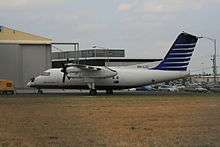Laser airborne depth sounder
The Laser airborne depth sounder (LADS) is an aircraft-based hydrographic surveying system used by the Australian Hydrographic Service (AHS).[1] The system uses the difference between the sea surface and the sea floor as calculated from the aircraft's altitude to generate hydrographic data.[1]

The lack of progress made in surveying Australia's territorial waters, most of which was unsurveyed or relying on Age of Sail-era charts prompted the Royal Australian Navy to seek a method of effectively surveying large areas from the air in the 1970s.[2] The Defence Science and Technology Organisation developed the LADS system, with feasibility trials beginning 1977.[1][2]
The LADS system is built around a Nd:YAG laser, which emits an infra-red beam at 990 hertz.[2] The beam is frequency doubled to produce a green laser.[2] This is split into two beams, one infra-red, one green, by an optical coupler, with the infra-red beam aimed directly below the aircraft, and the green beam directed across the target area with a scanning mirror.[2] The infra-red laser does not penetrate the water's surface, and its reflected pulse indicates the height of the aircraft above the surface.[2] However, the green laser penetrates to the ocean floor, and the return pulse from the green laser indicates the height of the aircraft from the ocean floor; the difference between the two values is used to calculate the water's depth.[2] The data from the lasers is not processed aboard the aircraft, but instead by a ground support team, with aircraft flight data and global positioning system information used to help generate hydrographic readings.[2] The aircraft makes multiple, overlapping passes of the target area to ensure accurate data is collected.[2] The LADS system is capable of taking 990 soundings per second, with data points positioned 2 to 6 metres (6 ft 7 in to 19 ft 8 in) apart across a swath up to 288 metres (945 ft) wide.[2] The system is capable of working with waters up to 70 metres (230 ft) deep, and can be modified to perform land surveys of areas with an altitude variance less than 50 metres (160 ft)
LADS entered service with the AHS in 1993.[1] The equipment was initially fitted to a Fokker F27 Friendship aircraft.[1] In 2010, the system was installed in a de Havilland Canada Dash 8 aircraft.[1] This is operated by the Laser Airborne Depth Sounder Flight of the Royal Australian Navy.
Citations
- Slade, in Oldham, 100 Years of the Royal Australian Navy, p. 171
- "LADS II (laser airborne depth sounder)". Australian Hydrographic Office. Archived from the original on 12 June 2011. Retrieved 26 June 2011.
References
- Slade, Kevin (2011). "History of the Australian Hydrographic Service". In Oldham, Charles (ed.). 100 Years of the Royal Australian Navy. Bondi Junction, NSW: Faircount Media Group. OCLC 741711418. Retrieved 20 June 2011.